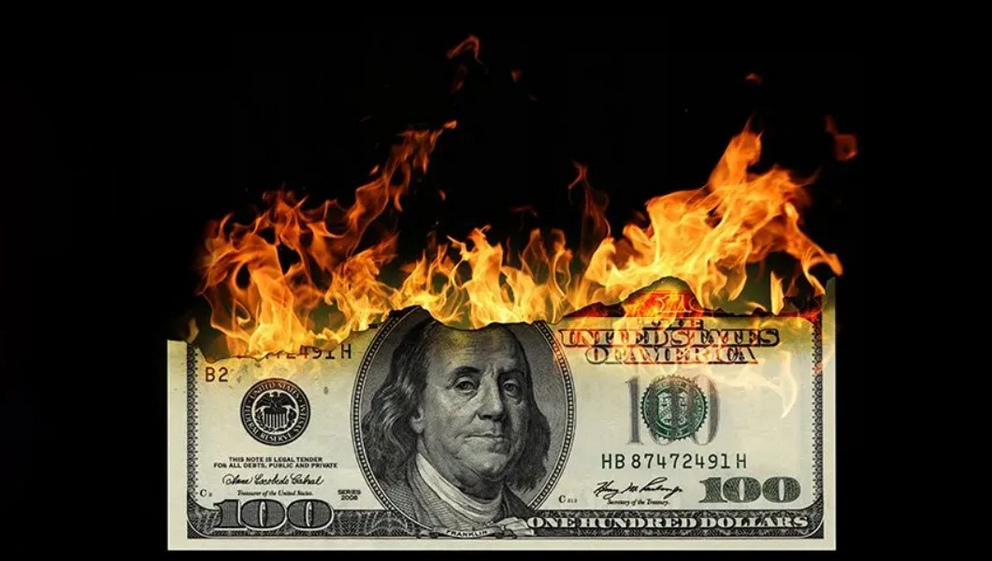Growing BRICS spells imminent end of US dollar
The dollar has functioned as the world’s reserve currency since 1921. The chart below shows that each of the world’s six reserve currencies since 1400 lasted about 94 years. Since the US dollar has already lasted 102 years, it is not unusual that it is at the end of its reign now.
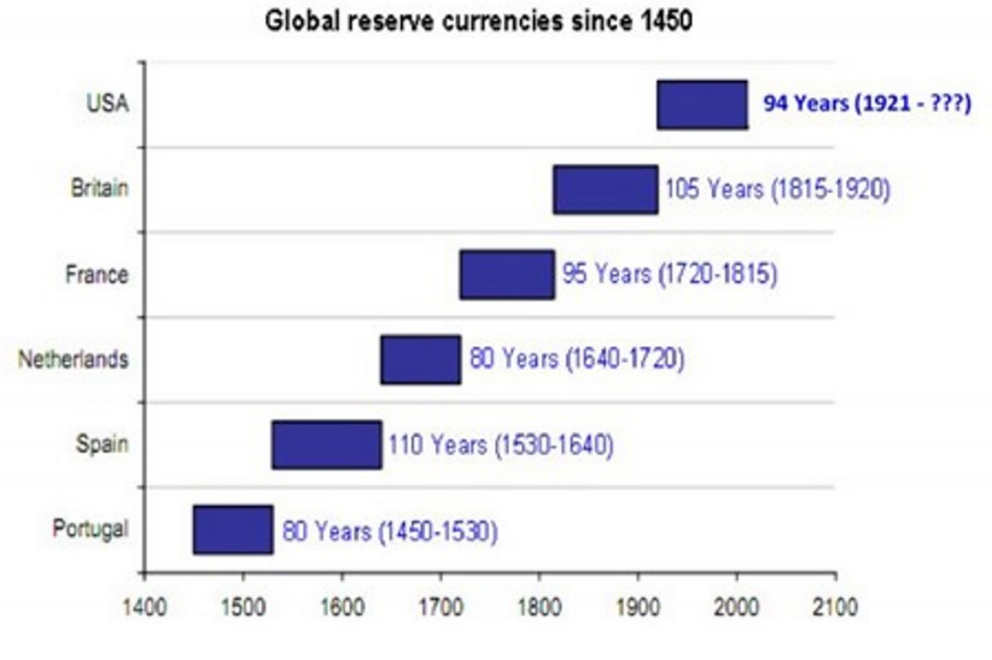
The US dollar was backed by gold until 1933 when President Franklin Roosevelt confiscated America’s gold. President Richard Nixon took the US dollar completely off gold in 1971 when he pegged it instead to oil — creating the “petrodollar”. Nixon reached an agreement with the Middle East oil producing nations that they would sell their oil only in dollars — forcing all nations who purchased oil from them to use dollars. The chart below shows how much the purchasing power of the dollar has declined.
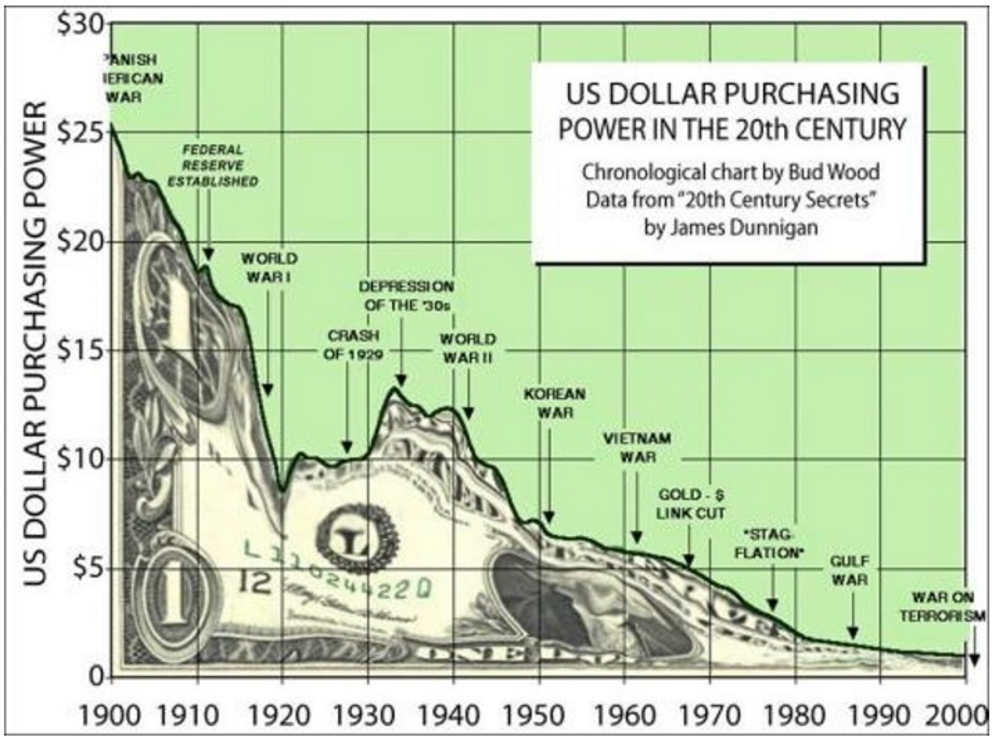
WTF 1971? shows the enormous consequences of taking the dollar off the gold standard.
The economy changed because of what happened in 1971.
Global Power Shift From US Dollar To Growing BRICS Nations
The video below with Robert Kiyosaki discusses the growing shift from the US dollar to the BRICS nations (Brazil, Russia, India, China, and South Africa) and to the Shanghai Cooperation Organization. Andy Schectman, CEO of Miles Franklin Precious Metals Investments, discusses China’s New Silk Road and the infrastructure it is building throughout the Middle East and Africa. China is making friends and forging collaboration between nations. Former US allies are now joining BRICS — Australia, Mexico, New Zealand, and possibly Japan. So, the US, Canada, the UK, and parts of the European Union are now isolated from the rest of humanity.
Meanwhile, the US has spent over 20 years in the endless War on Terror, some of the horrors of which Australian author Julian Assange revealed with WikiLeaks. He has been punished for telling the truth by many years in the Ecuadorian Embassy and now four years in the harsh Belmarsh prison trying to avoid extradition to the US where he could be sentenced to 175 years in jail — for telling the truth!
“Rich Dad/Poor Dad” Robert Kiyosaki explains that the growing centralization of US banks is a step toward communism. How ironic it is that Communist China is moving toward decentralization with the BRICS economy! Kiyosaki has never done an Emergency Broadcast before, but has done three recently.
Emergency Podcast #1
In the video below, Schectman explains that the banks may be allowed to fail to justify the rollout of a Central Bank Digital Currency as a “savior of the banking system”. He points out that the Bank for International Settlements (BIS) said all member nations must have CBDCs by 2025. Fed Takes Key Step in Deciding on U.S. Digital-Coin Issuance. Schectman predicts lots of bank runs, starting with small regional banks.
Emergency Broadcast #1 – Banks Too Big to Fail
The institutions that are deemed “too big to fail” will always be bailed out. In his book Conspiracy of the Rich: The 8 New Rules of Money, Robert Kiyosaki wrote that “bailouts are the name of the game.” This week, the Fed bailed out two regional banks that collapsed. As depositors of those banks feared money in their accounts was gone, the Fed stepped in to replenish any of the money depositors would have lost — including accounts holding over $250,000. Janet Yellen, Treasury Secretary, told senators that this guarantee will not be extended to smaller regional banks in the future. Lawmakers are concerned these backstops could become a new norm for big banks, giving “too big to fail” banks an unfair advantage over community lenders.
Emergency Podcast #2
New Global Reserve Currency – SPECIAL EPISODE – Robert Kiyosaki, Andy Schectman
Emergency Podcast #3
Robert Kiyosaki plays a video by the President William Ruto of Kenya who warns people to get out of the dollar because the market is going to change in a couple of weeks. Andy Schectman explains that everything in the US could change in the blink of an eye. He asks, “What does it mean when the dollar dies along with stocks, bonds, and real estate?”
Schectman explains that this is the first time in five centuries that the global agenda is not being set by the West. Instead, China is helping to build infrastructure in Africa and South America as well as alliances throughout the Middle East. He pointed out the President Xi of China explained to Putin recently that the changes they are making now have not happened in 100 years. Schectman says America is facing a 100-year hurricane now.
Kiyosaki points out that the US is facing the possibility now of hyperinflation as happened in Germany’s Weimar Republic in the 1923 and in Zimbabwe recently. In that situation cash becomes trash that can’t buy anything. He recommends buying a silver coin which now sells for about $35, but also shows a gold coin which sells for about $2,000.
Is It Over for the US Dollar? – SPECIAL EPISODE – Robert Kiyosaki, Andy Schectman
Robert Kiyosaki and Andy Schectman discuss the current state of the economy and potential risks that people should be aware of. They refer to three emergency podcasts covering different topics, including the safety of people’s money in banks, the potential consequences of the US losing its petrol reserve status, and the risks associated with the failure of Deutsche Bank.
It’s important to note that the safety of people’s money in banks is a growing concern, especially with the increasing number of bank failures and the possibility of a global recession. Additionally, the US losing its petrol reserve status could have significant implications for the country’s economy, as it would mean a loss of power and influence in the global market.
The risks associated with the failure of Deutsche Bank are not to be taken lightly, as it is one of the largest banks in Europe and its collapse could have a domino effect on the global financial system. To protect oneself from potential economic crises, Robert and Andy stress the importance of investing in precious metals, particularly silver. This is because silver has historically been a safe haven asset during times of economic uncertainty.
They also discuss China’s role in building infrastructure and industrializing countries in a mutually beneficial way. This is an important point to consider, as China’s economic growth has had a significant impact on the global economy and its policies can have far-reaching consequences.
Host Robert Kiyosaki calls this episode “Emergency Podcast #3” while guest Andy Schectman, CEO of Miles Franklin Precious Metals Investments, talks about the first two “Emergency podcasts.” Emergency Podcast #1 talked about how the FDIC and the federal reserve bank will determine what banks live or die. “There are roughly 5,000 of these regional banks,” says Schectman. “These banks are responsible for 70% of all small business loans, which is part of the 40% of GNP of our country.”
As the majority of small businesses in America have relied on these regional banks, Kiyosaki and Schectman discuss whether or not one should stay with the relationship they have and prepare for the worst, or take their money and move it into a handful of very large commercial banks. The question is, “Is your money safe in a bank or is it going to be stolen by the banks — called a “bail-in,” as Kiyosaki says.
United States Secretary of the Treasury Yellen lit a fuse under 5,000 banks in this country…forcing everyone into a handful of corporate banks. “It’s centralized banking, they control the whole economy, run by the academic elite…
Mexico has formally applied to BRICS and the rumor is Japan, Australia, and New Zealand are contemplating joining it. This group is reeling against this type of hegemony, symbolizing how the United States and its actions have done more to destroy itself in the past few years than any external enemy could do. “We weaponize our source of power—the US dollar.”
The Ramifications are hyperinflation. When 70% of the world’s population says they aren’t going to use this currency anymore. As the President of Kenya says, “Those of you who are holding dollars, you better do what you must do. Because this market is going to be different in a couple of weeks.” In other words, get out of dollars and do it quickly,” as Schectman says. “When the dollar dies, along with stocks, bonds, and real estate, people will come knocking. And when people have nothing to lose, they lose it!”
Kiyosaki says, “I would rather have this $35 coin than this “toilet paper.”
Global South Unites Against Woke West
The BRICS nations were created as an alternative to the G7 (US, Canada, UK, France, Germany, Italy, and Japan). The BRICS GDP has already surpassed that of the G7. With the exception of Russia, the BRICS are part of the “Global South” — nations which have often felt victimized or marginalized by the Global North. This is the emergence of a new era of mutually-beneficial collaboration. Now, 70% of the world’s population that used to use the dollar are moving toward the BRICS currency. Schectman said in Emergency Broadcast #3 that Russia has endorsed using the Chinese Yuan as a bridge currency until the BRICS nations create a new digital currency. BRICS Currency Launch Confirmed – (Dedollarization & Silver).
Algeria, Argentina, and Iran have applied to join BRICS. Saudi Arabia, Türkiye, Egypt, and Afghanistan are interested, along with Indonesia which is expected to make a formal application to join at the upcoming G20 summit in Bali. Kazakhstan, Nicaragua, Nigeria, Senegal, Thailand, and the United Arab Emirates are other likely candidates for membership.
Schectman points out that the oil producing nations are not supportive of the West’s Green New Deal or the Woke agenda of companies like Black Rock which are the “stakeholders” Klaus Schwab, founder of the World Economic Forum, says will replace shareholders in capitalism.
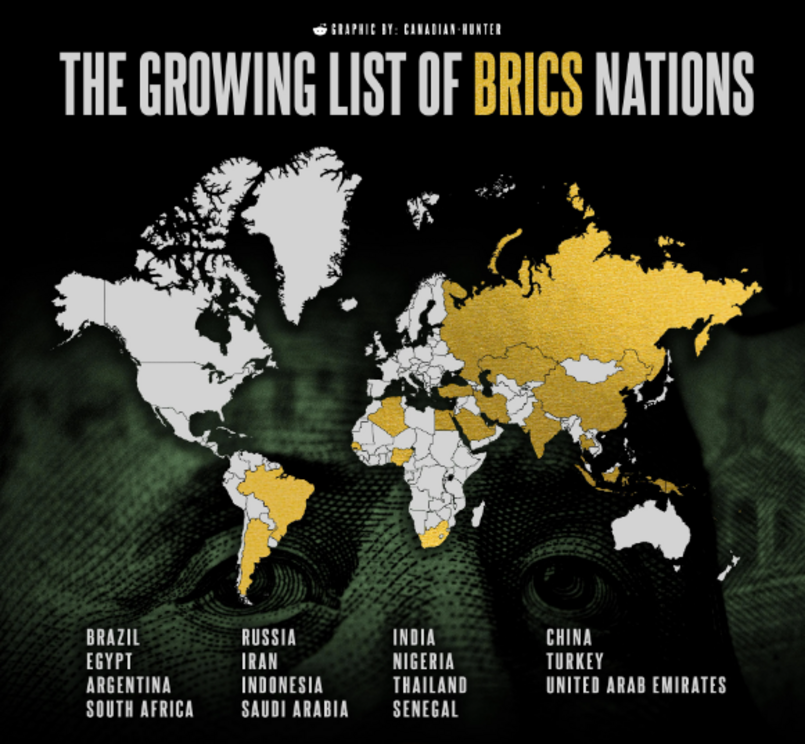
Global South’s Gold-Backed Currencies
Global South: Gold-backed currencies to replace the US dollar
“The adoption of commodity-backed currencies by the Global South could upend the US dollar’s dominance and level the playing field in international trade.”
By Pepe Escobar
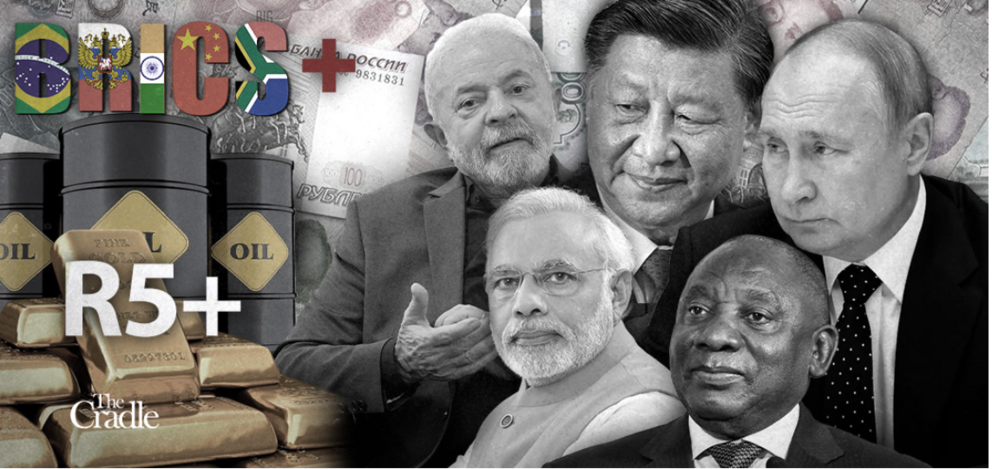
Let’s start with three interconnected multipolar-driven facts.
First: One of the key take aways from the World Economic Forum annual shindig in Davos, Switzerland is when Saudi Finance Minister Mohammed al-Jadaan, on a panel on “Saudi Arabia’s Transformation,” made it clear that Riyadh “will consider trading in currencies other than the US dollar.” So is the petroyuan finally at hand? Possibly, but Al-Jadaan wisely opted for careful hedging: “We enjoy a very strategic relationship with China and we enjoy that same strategic relationship with other nations including the US and we want to develop that with Europe and other countries.”
Second: The Central Banks of Iran and Russia are studying the adoption of a “stable coin” for foreign trade settlements, replacing the US dollar, the ruble and the rial. The crypto crowd is already up in arms, mulling the pros and cons of a gold-backed central bank digital currency (CBDC) for trade that will be in fact impervious to the weaponized US dollar.
A gold-backed digital currency
The really attractive issue here is that this gold-backed digital currency would be particularly effective in the Special Economic Zone (SEZ) of Astrakhan, in the Caspian Sea. Astrakhan is the key Russian port participating in the International North South Transportation Corridor (INTSC), with Russia processing cargo travelling across Iran in merchant ships all the way to West Asia, Africa, the Indian Ocean and South Asia.
The success of the INSTC – progressively tied to a gold-backed CBDC – will largely hinge on whether scores of Asian, West Asian and African nations refuse to apply US-dictated sanctions on both Russia and Iran. As it stands, exports are mostly energy and agricultural products; Iranian companies are the third largest importer of Russian grain. Next will be turbines, polymers, medical equipment, and car parts. Only the Russia-Iran section of the INSTC represents a $25 billion business. And then there’s the crucial energy angle of INSTC – whose main players are the Russia-Iran-India triad. India’s purchases of Russian crude have increased year-by-year by a whopping factor of 33. India is the world’s third largest importer of oil; in December, it received 1.2 million barrels from Russia, which for several months now is positioned ahead of Iraq and Saudi Arabia as Delhi’s top supplier.
‘A fairer payment system’
Third: South Africa holds this year’s rotating BRICS presidency. And this year will mark the start of BRICS+ expansion, with candidates ranging from Algeria, Iran and Argentina to Turkey, Saudi Arabia and the UAE. South African Foreign Minister Naledi Pandor has just confirmed that the BRICS do want to find a way to bypass the US dollar and thus create “a fairer payment system not skewed toward wealthier countries.”
For years now, Yaroslav Lissovolik, head of the analytical department of Russian Sberbank’s corporate and investment business has been a proponent of closer BRICS integration and the adoption of a BRICS reserve currency. Lissovolik reminds us that the first proposal “to create a new reserve currency based on a basket of currencies of BRICS countries was formulated by the Valdai Club back in 2018.”
Are you ready for the R5?
The original idea revolved around a currency basket similar to the Special Drawing Rights (SDR) model, composed of the national currencies of BRICS members – and then, further on down the road, other currencies of the expanded BRICS+ circle. Lissovolik explains that choosing BRICS national currencies made sense because “these were among the most liquid currencies across emerging markets. The name for the new reserve currency — R5 or R5+ — was based on the first letters of the BRICS currencies all of which begin with the letter R (real, ruble, rupee, renminbi, rand).”
So BRICS already have a platform for their in-depth deliberations in 2023. As Lissovolik notes, “in the longer run, the R5 BRICS currency could start to perform the role of settlements/payments as well as the store of value/reserves for the central banks of emerging market economies.”
It is virtually certain that the Chinese yuan will be prominent right from the start, taking advantage of its “already advanced reserve status.” Potential candidates that could become part of the R5+ currency basket include the Singapore dollar and the UAE’s dirham. Quite diplomatically, Lissovolik maintains that, “the R5 project can thus become one of the most important contributions of emerging markets to building a more secure international financial system.”
The R5, or R5+ project does intersect with what is being designed at the Eurasia Economic Union (EAEU), led by the Macro-Economics Minister of the Eurasia Economic Commission, Sergey Glazyev.
A new gold standard
In Golden Ruble 3.0 , his most recent paper, Glazyev makes a direct reference to two by now notorious reports by Credit Suisse strategist Zoltan Pozsar, formerly of the IMF, US Department of Treasury, and New York Federal Reserve: War and Commodity Encumbrance (December 27) and War and Currency Statecraft (December 29).
Pozsar is a staunch supporter of a Bretton Woods III – an idea that has been getting enormous traction among the Fed-skeptical crowd. What’s quite intriguing is that the American Pozsar now directly quotes Russia’s Glazyev, and vice-versa, implying a fascinating convergence of their ideas. Let’s start with Glazyev’s emphasis on the importance of gold. He notes the current accumulation of multibillion-dollar cash balances on the accounts of Russian exporters in “soft” currencies in the banks of Russia’s main foreign economic partners: EAEU nations, China, India, Iran, Turkey, and the UAE.
He then proceeds to explain how gold can be a unique tool to fight western sanctions if prices of oil and gas, food and fertilizers, metals and solid minerals are recalculated:
“Fixing the price of oil in gold at the level of 2 barrels per 1g will give a second increase in the price of gold in dollars, calculated Credit Suisse strategist Zoltan Pozsar. This would be an adequate response to the ‘price ceilings’ introduced by the west – a kind of ‘floor,’ a solid foundation. And India and China can take the place of global commodity traders instead of Glencore or Trafigura.”
So here we see Glazyev and Pozsar converging. Quite a few major players in New York will be amazed.
Glazyev then lays down the road toward Gold Ruble 3.0. The first gold standard was lobbied by the Rothschilds in the 19th century, which “gave them the opportunity to subordinate continental Europe to the British financial system through gold loans.” Golden Ruble 1.0, writes Glazyev, “provided the process of capitalist accumulation.”
Golden Ruble 2.0, after Bretton Woods, “ensured a rapid economic recovery after the war.” But then the “reformer Khrushchev canceled the peg of the ruble to gold, carrying out monetary reform in 1961 with the actual devaluation of the ruble by 2.5 times, forming conditions for the subsequent transformation of the country [Russia] into a “raw material appendage of the Western financial system.”
What Glazyev proposes now is for Russia to boost gold mining to as much as 3 percent of GDP: the basis for fast growth of the entire commodity sector (30 percent of Russian GDP). With the country becoming a world leader in gold production, it gets “a strong ruble, a strong budget and a strong economy.”
All Global South eggs in one basket
Meanwhile, at the heart of the EAEU discussions, Glazyev seems to be designing a new currency not only based on gold, but partly based on the oil and natural gas reserves of participating countries. Pozsar seems to consider this potentially inflationary: it could be if it results in some excesses, considering the new currency would be linked to such a large base. Off the record, New York banking sources admit the US dollar would be “wiped out, since it is a valueless fiat currency, should Sergey Glazyev link the new currency to gold. The reason is that the Bretton Woods system no longer has a gold base and has no intrinsic value, like the FTX crypto currency. Sergey’s plan also linking the currency to oil and natural gas seems to be a winner.”
So in fact Glazyev may be creating the whole currency structure for what Pozsar called, half in jest, the “G7 of the East”: the current 5 BRICS plus the next 2 which will be the first new members of BRICS+.
Both Glazyev and Pozsar know better than anyone that when Bretton Woods was created the US possessed most of Central Bank gold and controlled half the world’s GDP. This was the basis for the US to take over the whole global financial system.
Now vast swathes of the non-western world are paying close attention to Glazyev and the drive towards a new non-US dollar currency, complete with a new gold standard which would in time totally replace the US dollar.
Pozsar completely understood how Glazyev is pursuing a formula featuring a basket of currencies (as Lissovolik suggested). As much as he understood the groundbreaking drive towards the petroyuan.
He describes the industrial ramifications thus:
“Since as we have just said Russia, Iran, and Venezuela account for about 40 percent of the world’s proven oil reserves, and each of them are currently selling oil to China for renminbi at a steep discount, we find BASF’s decision to permanently downsize its operations at its main plant in Ludwigshafen and instead shift its chemical operations to China was motivated by the fact that China is securing energy at discounts, not markups like Europe.”
The race to replace the dollar
One key takeaway is that energy-intensive major industries are going to be moving to China. Beijing has become a big exporter of Russian liquified natural gas (LNG) to Europe, while India has become a big exporter of Russian oil and refined products such as diesel – also to Europe. Both China and India – BRICS members – buy below market price from fellow BRICS member Russia and resell to Europe with a hefty profit. Sanctions? What sanctions?
Meanwhile, the race to constitute the new currency basket for a new monetary unit is on. This long-distance dialogue between Glazyev and Pozsar will become even more fascinating, as Glazyev will be trying to find a solution to what Pozsar has stated: tapping of natural resources for the creation of the new currency could be inflationary if money supply is increased too quickly.
All that is happening as Ukraine – a huge chasm at a critical junction of the New Silk Road blocking off Europe from Russia/China – slowly but surely disappears into a black void. The Empire may have gobbled up Europe for now, but what really matters geoeconomically, is how the absolute majority of the Global South is deciding to commit to the Russia/China-led block.
Economic dominance of BRICS+ may be no more than 7 years away – whatever toxicities may be concocted by that large, dysfunctional nuclear rogue state on the other side of the Atlantic. But first, let’s get that new currency going.
The views expressed in this article do not necessarily reflect those of The Cradle.”
Fed To Introduce FedNow in July
- Federal Reserve announces July launch for the FedNow Service
- FedNow Isn’t a CBDC, But Still Contains Many Dangers
Florida To Ban Central Bank Digital Currencies
Ron DeSantis Unveils Plan To Oppose ‘Big Brother’s Digital Dollar’ As 2024 Buzz Intensifies
“Potential 2024 presidential candidate Gov. Ron DeSantis (R-FL) details his opposition to any form of central bank digital currency, calling it “Big Brother’s Digital Dollar.”

